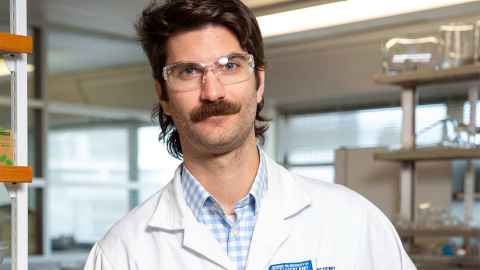Plastic levels in indoor Auckland air much higher than at outdoor site
26 May 2025
How much plastic are we inhaling where we work and live?

Scientists at Waipapa Taumata Rau, University of Auckland are investigating just how much plastic New Zealanders are inhaling, especially indoors where most people spend most of their time.
Dr Joel Rindelaub and Dr Gordon Miskelly, of the School of Chemistry, tested the air in two chemistry labs for microplastics small enough to be inhaled, particles similar in size to fine silt or sand or pollen.
The average concentration of plastic was 830 nanograms per cubic metre of air, more than ten times higher than a reading at an outdoor site elsewhere.
A nanogram is one billionth of a gram.
“Most of us spend most of our time indoors, that’s how we live,” says Rindelaub. “And since indoor levels of microplastics are generally higher than outdoors, we need to know much, much more about our exposures and the potential health risks.”
Importantly, chemical additives, which may pose greater health risks than the plastics themselves, were also detected. Phthalates, endocrine disrupting chemicals used to make plastics flexible, were present at an average level of 334 nanograms per cubic metre.
Globally, scientists have yet to standardise methods for measuring microplastics, with many past studies undercounting by failing to pick up the very smallest particles, which are also the most numerous.
The average concentration of plastic in two chemistry labs was 830 nanograms per cubic metre of air, more than ten times higher than a reading at an outdoor site elsewhere.
In addition to detection in the human liver, blood, faeces, and placenta, microplastics can lodge in the lungs and US scientists have analysed brains containing the equivalent of five plastic bottle caps.
Rindelaub hopes the fast and simple chemical technique trialled in his research using pyrolysis gas chromatography mass spectrometry becomes more common internationally.
Seven types of plastic were detected in the laboratory air, likely coming from sources such as building materials, lab equipment and packaging, according to the study in the Journal of Exposure Science & Environmental Epidemiology.
The highest concentrations were of polycarbonate, polyvinylchloride, and polyethylene.
A separate study by Rindelaub and his colleagues, published in the journal Environmental Pollution, tested coastal air at a site about 50 km west of Invercargill. Here, the average concentration of inhalable microplastics was 65 nanograms per cubic metre of air – comparable to an average of hugely variable urban readings around the world.
Based on wind direction, the Southern Ocean seemed to be the key source of the plastic, acting as a reservoir of particles, likely propelled into the air via breaking waves.
Rindelaub and his colleagues found about 4,625 microplastics per square metre of surface area per day in the Southland study, similar to about 4,885 in a previous study in Auckland.
The Auckland amount was the equivalent of 3 million plastic bottles falling from the sky a year.
“Detecting similar amounts in a remote area and a big city indicates there is a lot of plastic coming to us from the ocean,” Rindelaub says.
What can you do?
Avoid using plastic when possible; don’t eat food from heated plastic containers since they leach chemical additives; ventilate your home and if possible, get a home air purifier, says Rindelaub.
Media contact
Paul Panckhurst | science media adviser
M: 022 032 8475
E: paul.panckhurst@auckland.ac.nz